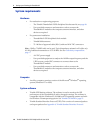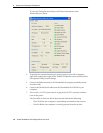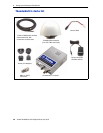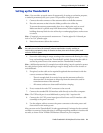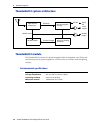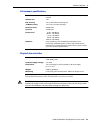
2 Setting up and Running the ThunderBolt E
18 Trimble ThunderBolt E GPS Disciplined Clock User Guide
Timing information
Packet 0x8F-AB (primary timing information) and packet 0x8F-AC (supplemental
timing information) contain most of the information that you need to monitor the
ThunderBolt E. In the default configuration, these packets are broadcast once per
second.
Elevation Mask
This is the minimum elevation angle for satellites that is used in a solution output by
the receiver (see Command Packet 0xBB: Set Receiver Configuration, page 62).
Satellites that are near the horizon are typically more difficult to track due to signal
attenuation, and are generally less accurate due to higher variability in the ionospheric
and tropospheric corruption of the signal. When there are no obstructions, the receiver
can generally track a satellite to near the horizon. However, when this mask is set too
low, the receiver may experience frequent constellation switching due to low elevation
satellites being obscured.
Frequent constellation switching is associated with undesirable timing jumps. If the
mask setting is too high, it may reject good satellites. The current mask is set to ten
degrees and provides a reasonable trade-off between the benefits and drawbacks.
Signal Level Mask
This mask defines the minimum signal strength for a satellite used in a solution. There
is some internal hysteresis on this threshold that allows brief excursions below the
threshold if lock is maintained and the signal was previously above the mask. The
factory default mask is zero. High accuracy users may use a slightly higher mask of 6.0
to 8.0, since weaker measurements may be slightly noisier and are often caused by
reflected signals that provide erroneous ranges.
Note – A level of hysteresis in the signal level mask is allowed in the core operating
software. The hysteresis allows the receiver to continue using satellite signals that fall
slightly below the mask and prevents the receiver from incorporating a new signal until the
signal level slightly exceeds the mask. This feature minimizes constellation changes caused
by temporary fluctuations in signal levels.
Reference position
When the antenna is connected and power is applied, the GPS module generates a
precise PPS signal, a 10 MHz frequency output, and several miscellaneous periodic
outputs. It calculates a clock-only solution from the GPS data. In clock-only
(position-hold) mode, a static reference position is established and all of the available
satellites are used to solve for a time solution. The reference position may be
determined automatically by the ThunderBolt E (self-survey) or may be uploaded to
the ThunderBolt E by the host, if the position is known. The accuracy and integrity of
the timing solution is highly dependent on the accuracy of the reference position.







